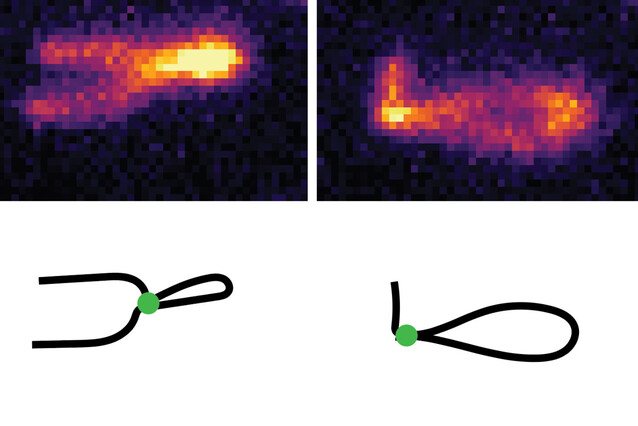ERC Advanced Grant for Jan-Michael Peters’ research on genome architecture
The folding of DNA is of fundamental importance for all life, but how the process works is a mystery. IMP Scientific Director Jan-Michael Peters was just awarded a highly competitive ERC Advanced Grant to elucidate the mechanism of DNA organisation over the next five years.
In the last call under the EU’s Horizon 2020 program, IMP Scientific Director Jan-Michael Peters was among only eight percent of applicants who succeeded in securing an ERC Advanced Grant. The ERC’s funding scheme for the most experienced researchers will support Jan-Michael Peters and his research group to study the mechanisms of DNA organisation over the next five years.
DNA was discovered 150 years ago, later identified as the medium of hereditary information, and studied intensively ever since. Today, scientists understand in detail how genomic DNA is replicated, repaired and segregated, and can sequence entire genomes. But what remains a mystery is how DNA is folded in chromosomes.
This folding process is essential for the function of the genome and is therefore driven by mechanisms that must work with high precision and efficiency: human DNA, for example, extends over two metres, which is folded to fit into the microscopic cell nucleus. To convey what a feat this is, Jan-Michael Peters often illustrates this process by putting it into proportion: if the nucleus was as big as a football, it would hold an 80-kilometre-long string of DNA.
From simple ring to molecular motor
Scientists have suggested that DNA is folded through a process called loop extrusion. This model proposes that so-called “SMC complexes”, enzymes that are present in all kingdoms of life, reel genomic DNA into loops, thereby pulling distant sections together. This process is thought to have important functions, such as the separation of bacterial genomes, the folding of DNA into loops and topologically associating domains (TADs) in the more complex eukaryotic organisms, facilitating sister chromatid resolution, gene regulation, and immunoglobulin gene recombination.
Scientists from the lab of Jan-Michael Peters at the IMP recently discovered that single molecules of the SMC complex cohesin which are bound to the protein NIPBL indeed rapidly extrude DNA into loops. This finding is the first direct piece of evidence for the hypothesis that cohesin is a “molecular motor” that generates chromatin loops and TADs by extrusion.
Watching cohesin in action
The most fundamental questions relating to this process, however, are still open: what is the mechanism of loop extrusion? How is this process controlled? How does cohesin extrude chromatin fibres in cells? And how does this contribute to the processes mentioned above and to other functions? To address these questions, the ERC-funded research project will apply cutting-edge techniques such as the recently discovered single-molecule loop extrusion assay.
The answers will be essential for understanding genome architecture and how it is regulated. They will provide insights into mechanisms of gene regulation and recombination, and will reveal how SMC complexes function as molecular “motors”.
Malfunctions of cohesin and NIPBL underlie human disorders such as several widespread cancers, rare congenital “cohesinopathies”, trisomies, and spontaneous abortions. The research project may therefore also provide insights into the mechanisms that cause these conditions.
The grant is the second ERC Advanced Grant for Jan-Michael Peters, building on a previous achievement from 2015. The IMP is looking back on a series of successes with ERC grants: between 2014 and 2018, the IMP ranked third among 172 European organisations in having the highest application success rate. In addition, out of the current 16 IMP faculty members, 13 are or have been supported by the ERC. At the neighbouring Institute of Molecular Biotechnology (IMBA) of the Austrian Academy of Sciences, a project by Daniel Gerlich was also just selected, yielding a double victory for research at the Vienna BioCenter in 2021.
***
About the ERC
The European Research Council (ERC), set up by the European Union in 2007, is the premier European funding organisation for excellent frontier research. Every year, it selects and funds the very best, creative researchers of any nationality and age, to run projects based in Europe. The ERC offers four core grant schemes: Starting, Consolidator, Advanced and Synergy Grants. With its additional Proof of Concept grant scheme, the ERC helps grantees to bridge the gap between their pioneering research and early phases of its commercialisation. The overall ERC budget from 2021 to 2027 is more than 16 billion Euro.
About the IMP at the Vienna BioCenter
The Research Institute of Molecular Pathology (IMP) in Vienna is a basic biomedical research institute largely sponsored by Boehringer Ingelheim. With over 200 scientists from 40 countries, the IMP is committed to scientific discovery of fundamental molecular and cellular mechanisms underlying complex biological phenomena. The IMP is part of the Vienna BioCenter, one of Europe’s most dynamic life science hubs with over 2,000 employees from 80 countries in four research institutes, three universities and 35 biotech companies. www.imp.ac.at, www.viennabiocenter.org
